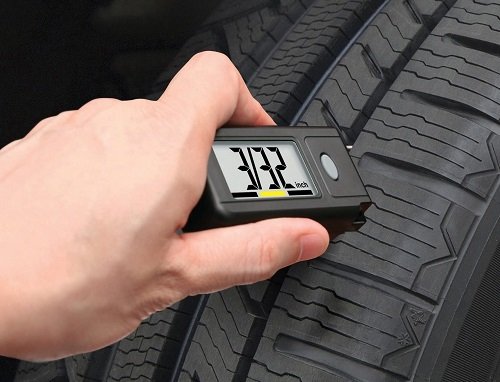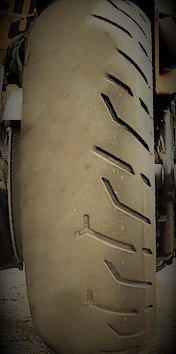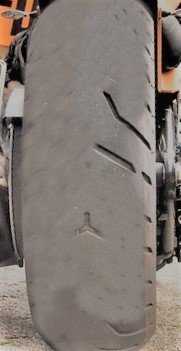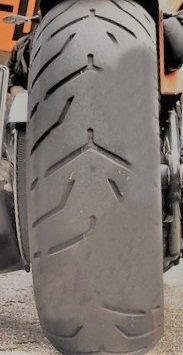When to replace motorcycle tires
Updated on | By Mohit Chauhan

Wondering when to replace your motorcycle tire? This is indeed a very popular subject amongst motorcyclists and definitely the one which needs some clarification and transparency. Certainly, every biker has dealt with a worn tread and has questioned whether to wait or to replace the tires without any delay.
We are all aware that a motorcycle tire is the vehicle’s only connection with the road. As a result, motorcycle’s handling characteristics are significantly dependent on the quality and condition of the tire. To ensure your own safety, it is essential you can recognize worn tires promptly so that you can react in a timely manner.
In today’s post we will share with you some useful suggestions on when to replace your motorcycle tires. But that’s not all we are going to discuss; we will also inform you about the rules and regulations surrounding the motorcycle tires as well as when one can repair a tire and not necessarily change them.
So let us begin!
Do motorcycle tires go bad with age?
As you are already aware, tires are made of rubber compound; a brand-new motorcycle tire will thus possess a lot of traction and will practically stick to the asphalt while riding. But this property diminishes with time and the rubber of the tire becomes harder and more brittle. For this reason, while purchasing a motorcycle tire, it is important to consider the date of manufacturing.
Why? Since the properties of the polymers used in motorcycle tires starts deteriorating after 6 years, it is important to pay attention to the date of manufacture, even if the dealer has stored these tires in a specialised warehouse.
Most of the motorcycle tires often age unnoticed, especially if the machine is seldom used. As the tires of a motorcycle that is parked in a garage most of the time loses its properties due to non-optimal environmental conditions and general aging, you should pay attention to the age of the tires and possible visible signs of aging (these include significant discoloration and cracks).
Manufacturers usually embed relevant product information on the sidewall of their motorcycle tires, however, there are only few who can understand it. One of the first conundrums riders usually run into is understanding the ‘DOT’. This number is either printed or engraved on the sidewall of the tire and indicates the date of manufacture (and not the best before date or expiration date). Therefore, as a motorcyclist, you should know how to read it correctly as it specifies not only the precise date of manufacturing, but also the production batch of the tire.

These four digits (printed at the last) are the production date; the first 2 being the week and the last 2 the year of production. For example: DOT CP7R P1X0 3112: Week 31 of 2012.
This part number was created by the U.S. Department of Transportation (DOT) to provide an efficient way of identifying the production date of the tire before it is installed on a motorcycle.
Note: Models that do not have DOT number, cannot be marketed in the U.S.
How long do motorcycle tires last?
It is actually the wear of a tire that is more important than its actual age in years. Typically, the one that is used more aggressively and more frequently, is the one that wears out the most. With each ride, the tread of the motorcycle tire wears down further. The lifespan of motorcycle tires therefore depends largely on how often and how intensively they are used.
This being said, under standard riding conditions, in case of touring tires, one can expect a lifespan of around 14,000 kilometers. Similarly, sport tires used for a more dynamic riding style can be expected to last around 6,000 kilometers. And, in case you only ride in city with standard motorcycle tires, they can last up to 60,000 kilometers.
Please note that a tire reaches its shelf life in about 6 years after the date of manufacture (DOT). This fundamental rule applies to all types of motorcycle tires, regardless of whether you have a touring or sport tire. Furthermore, there are some external factors that influence the life span of your tire:
- Incorrect tire pressure
- Weight
- Weather
- Parking / storage environment
How to tell if motorcycle tires need replacement?
Regardless of whether you are a daily commuter or a weekend rider, at some point you may have felt the need to replace your motorcycle tire. There are several factors that determine when they are due. In addition to wear and tear, aging is another major reason for purchasing new tires. In fact, if your tires are ideally stored and only lightly used, they will still be due for replacement after a certain period of time.
Legally speaking, the only requirement is that the minimum tread depth should be more than 1.6 millimeters, and this applies equally to cars as well as motorcycles. However, the wear marks visible on the tread grooves should not be used as a guide.
In accordance with the U.S. DOT standard, the TWI (Tread Wear Indicator) markings are only 0.8 millimeters high. A tire ages differently when it is on a rim than when it is in a tire store. Ultraviolet rays, humidity, and high temperatures all have an impact on the tire’s performance, reducing its efficiency noticeably, despite sufficient residual tread.
In most cases, severe wear and tear can be seen with the naked eye. For example, cracks, holes or cuts, as well as localized damage caused by nails. Although the damage caused by a nail can be repaired in many cases, the other types of wear and tear often requires a complete replacement.
Additionally, there are various types of tread wear that can indicate the need for a tire change (this includes ‘sawtooth’ wear).
You can tell that the tires are worn by observing their behavior on the road. On summer tires, you will notice a longer braking distance and poor handling response in damp conditions.
On winter tires, motorcycle will frequently swerve from its track. Furthermore, it will have a very poor traction. This is apparent from the fact that the tires slip as you start to accelerate.
Another simple technique to detect worn tires is by using a penny. Simply insert a penny inside the grooves of your tire’s tread with Lincoln’s head in downwards direction. If the head disappears completely into the tire tread, it is still high enough. However, if you can see all of the Lincoln’s head, you should consider replacing your tire.
To be absolutely sure, you can purchase a tread depth tester from any online/offline store. It is a cheap and reliable means of detecting worn tires. Insert the tip of the device into the tread groove and press it down. Then you can read off the exact value.

However, it is important to repeat this process in multiple spots when you measure the tread depth. In many cases, the wear in one area is different from another. It is therefore important to measure across several spots. This is because the road traffic regulations specifies that the minimum tread depth must be maintained throughout.
Curbs, potholes and other sharp objects can seriously damage a tire. Any perforation, tear or deformation should be carefully examined by a professional who can determine if the tire needs replacement.
As a rule of thumb, never travel with a flat or damaged tire.
Read more: How to prevent motorcycle tire punctures
There are a number of cases in which a tire cannot be repaired and needs to be replaced immediately.
- Punctures on the sidewalls
- Deformity on the surface of the tire
- Visible separation of the tread rubber
Advise: Keep a close check on the overall feel while riding; uneven or bumpy ride even on tarmac indicates possible tire damage or high wear and tear. So, if you notice vibrations or other disturbances while riding, immediately reduce your speed and gently stop near a safe parking spot. In case there are visible damages, ask a towing agency to drop your bike to nearest service station.
But what if everything actually looks good, in this case when should you replace your tires?
As a rule, we recommend replacing tires after every 6 years. In terms of properties, tires typically no longer demonstrate the same level of performance after 6 years than they used to. Especially, over time, the rubber compound becomes hard, the material wears out and becomes brittle. This is true even if, for example, the tread depth still meets the specifications and the tires do not look very worn. This can sometimes be annoying, especially for occasional riders, because even if the annual mileage is low, replacing the tires becomes inevitable.
Should you replace both motorcycle tires at the same time
For a biker, the tires are the primary connection with the road, which guarantees his stability. Consequently, replacing tires is an essential, if not mandatory, safety measure which should be done at regular intervals.
Contrary to cars, the rear tire on a motorcycle wears out very quickly as it is subjected to greater stress than the front tire due to the torque of the motorcycle. Despite the fact that today’s tire manufacturers take this parameter into account by offering you a different combination of front and rear tires, there is still a significant difference between the two. As a result, the rear tire needs to be changed more frequently and promptly than the front tire.
Given that budgetary considerations are always important at the time of purchase, it is often convenient to change only the most worn tire, which is usually the rear tire. However, remember that in this situation, the new rear tire might not deliver its maximum potential, as the performance of the motorcycle will be greatly reduced by the old tire.
Furthermore, each tire has a different tread pattern and structure, which may have different specifications, warm-up times, and engineering, while still being within the industry standard. These can also affect the maneuverability. Thus, for maximum safety and performance on the road, buying a complete set will allow you to get the most out of the tire’s capabilities.
Are mixed tires allowed on a motorcycle?
Often times we come across these queries; can I mix two different brands of tires on my motorcycle, or use summer and winter tires in combination, or just mix two different models while replacing the tires?
In general, the law does not prohibit the use of different tire models or manufacturers on two-wheeled vehicles. The only exception is when a tire brand is indicated in the registration certificate of the motorcycle. In this case, there is still the option of applying for a permit from the motorcycle or tire manufacturer. Thereby validating that the respective tire may be used for the motorcycle. However, this should only be done in case the recommended tire model has been discontinued.
Using tires of different brands, tread patterns and rubber compounds on a motorcycle can negatively influence the performance and handling of the motorcycle. That becomes particularly clear when the motorcycle is subjected to hydroplaning, cornering or while braking.
This difference is more pronounced when using a mix of summer and winter tires. Since, winter tires have a significantly different behavior due to the special rubber compound and tread design in comparison to the summer tires, the combination of these two types can be catastrophic.
Average life of motorcycle tires
As we have already discussed, it is possible to determine the actual age of a tire by looking at the DOT number, which is clearly labelled on the side of each tire. This is where you find a four-digit number representing the week and year of manufacture.
Any motorcycle tire that is older than 6 years should either be discontinued or should be inspected by a professional for any abnormalities. While some manufacturers advertise up to 10 years of tire life if stored properly, this type of storage however is not possible for someone without professional knowledge. Truth be told, it’s not just age per se that causes wear and tear of tires.
First of all, it is the total number of kilometers driven by a rider that actually determines the wear and tear of the rubber. After all, wheels are subjected to a lot of friction during operation, which wears away the top layer of the tire over time. Of course, the type of surface you ride on is also an important factor, as flat tarmac exerts less strain on the rubber than an off-road track filled with gravel. Along these lines, a lot of cornering also has an effect on the overall wear and tear of the tires. And finally, an incorrect pressure of the tires, which is equally significant and a contributing factor towards wear and tear.
Life of winter tires
In most cases, the treads of standard winter tires have deeper and wider grooves that grip around the snow to help prevent skidding. The average life of winter tires is approximately 6 years or 40,000 kilometers in standard conditions. However, the tread depth determines their usability depending on the riding style. Should these tires be used in hot temperatures, the probability of wear increases considerably thus reducing their lifespan. In addition to wear, using winter tires in the summer also results in longer braking distances.
Life of summer tires
A summer tire on the other hand can withstand moderate to hot weather conditions. And even at higher temperatures, its rubber compound will not become too soft.
Moreover, the tread of summer tire is engineered in such a way that it can also disperse substantial amount of water, which reduces the risk of hydroplaning.
The average life of summer motorcycle tires is around 40,000 kilometers to 60,000 kilometers in standard conditions. Alternatively, the tires perform efficiently for around 6 years, post which the rubber starts to deteriorate and eventually loses its durability.
Life of all-weather tires
All-weather tires have a considerably shorter life expectancy than summer or winter tires. In fact, they are no longer considered suitable for use once they have covered an estimated mileage of 35,000 kilometers, which is generally equivalent to 3 years.
Replace your motorcycle tires immediately if you observe these symptoms
Abnormal wear patterns are indications that needs to be addressed immediately. When you experience abnormalities on your motorcycle tire (as shown below), not only you need to replace the tires, but you also need to investigate the root cause.
Shown below are some of the most common wear patterns that occur on a motorcycle tire and should be addressed immediately.
Middle wear
Causes: Over inflation, aggressive riding and braking.
Action: Replace tires, inspect tire pressure regularly, avoid aggressive braking techniques (Read more here: How to apply motorcycle brakes properly).
One-sided shoulder wear
Causes: Faulty suspension, aggressive cornering.
Action: Replace tires, inspect suspension system, slow down while cornering (Read more here: Motorcycle cornering for beginners)
Both side wear
Causes: Underinflation, aggressive cornering.
Action: Replace motorcycle tires, inflate at recommended pressure, avoid aggressive cornering.
Diagonal wear
Causes: Faulty suspension, hard braking.
Action: Replace tires, inspect suspension, avoid sudden braking.
Spotting
Causes: Improper mounting of tire on the rim, very aggressive braking technique.
Action: Replace tire if the spot is of considerable size, mount the tire properly, avoid hard braking.
Bottom Line
No statutory age limit has been set for the mandatory replacement of motorcycle tires. Nevertheless, it should be borne in mind that the motorcycle tires are primarily composed of rubber and this material becomes hard and brittle over time. Therefore, tires should be replaced after 6 years as a rule.
If the depth of the tire tread is less than 1.6mm, you need to replace the tires immediately.
There are many factors that influence the longevity of motorcycle tires. Depending on your riding style, speed, tire pressure, and load distribution it can vary significantly. In order to ensure optimum safety, we recommend checking the tire pressure and the condition of the wheels on a regular basis. Any type of crack or deformation is a clear indication of tire wear.
And lastly, when you purchase a new tire, it must be no older than 3 years to be considered as “new”. The DOT number on the sidewall of the tire is a simple way to determine the date of manufacturing.
Good luck!









